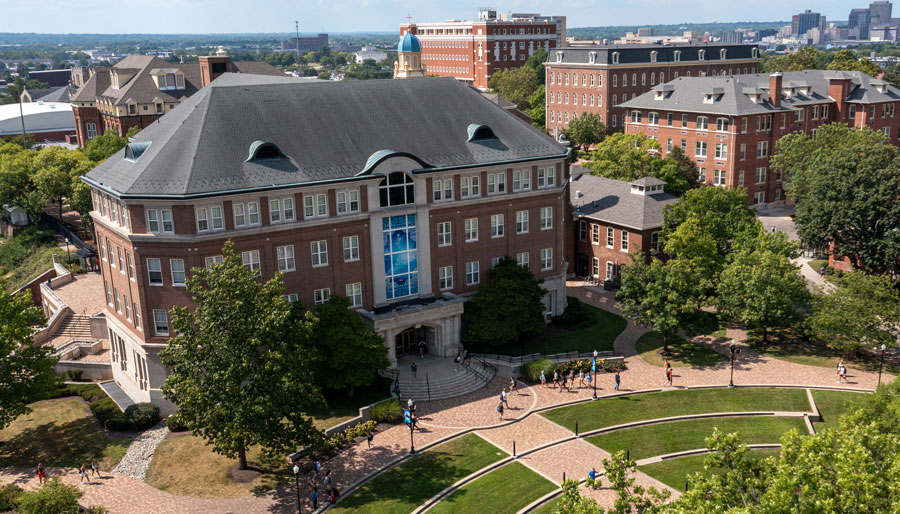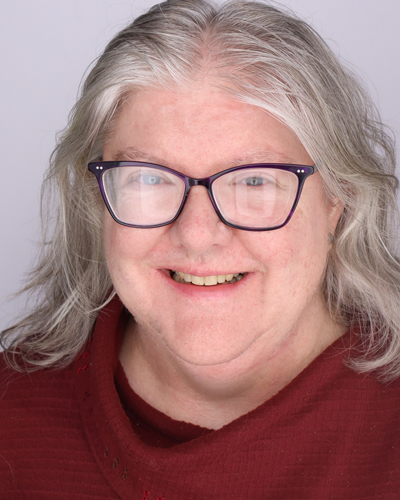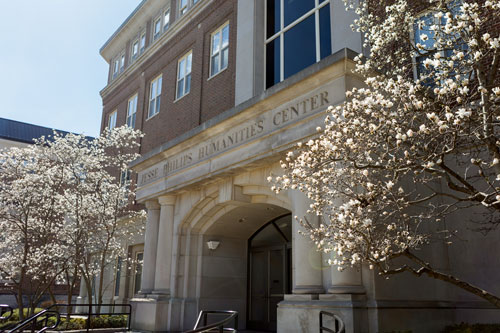30 years in the humanities building
Thirty years ago — Sunday, Oct. 24, 1993 — the Jesse Phillips Humanities Center was dedicated. In August of that year we moved into the building, newly constructed on a grassy slope it was hard to lose, along with the large rose garden that used to be on the west side of Alumni Hall.

The five departments that moved in — English, languages, religious studies, history and philosophy — had previously been scattered among three other buildings on campus.
“That physical move was a concrete expression of a metaphorical, intellectual move to strengthen the role of the humanities in the University’s curriculum.”
That physical move was a concrete expression of a metaphorical, intellectual move to strengthen the role of the humanities in the University’s curriculum. The recently implemented general education program (the Common Academic Program’s immediate predecessor) was the first to include a “humanities base,” in which four courses in English, history, philosophy and religious studies introduced students to university-level humanities studies. The base was organized around the question, “What does it mean to be human?” and four accompanying themes examining the individual and community, autonomy and responsibility, humans and nature, and faith and reason.

Adopting the humanities base and housing all the departments in one building acknowledged that all study and learning are at their deepest and highest levels profoundly integrated and inescapably communal, despite how solitary some aspects of research can be. Further, this integration reflected the Catholic belief that all knowledge of the created world is knowledge of the mind of the Creator.
The move also reflected a stage in the history of U.S. Catholicism and UD’s place in that unfolding story. Like so many Catholic colleges and universities, it had been founded largely to educate the descendants of immigrants and help them to gain a foothold on the ladder of intergenerational social mobility. There are stories of UD being known for part of its history as “Jesus Tech,” reflecting the centrality of that mission.
By the 1980s, UD along with many other U.S. Catholic colleges and universities had grown rapidly in size thanks to the GI Bill of Rights and the baby boom. We had also undergone the profound transformation that accompanied the shift to lay control — from the era when university ownership and decision-making lay solely with the founding religious congregation to the new era of lay boards and a commitment to academic freedom and the ethos of the wider academy.

Many worried, not without good reason, that Catholic higher education would follow the path of other U.S. universities, so many of which had begun as religious institutions and were by the 1980s wholly and proudly “secular.” Was that an inevitable trajectory that we had to follow in order to be considered — or simply to be — “excellent?”
UD along with other institutions wagered quite a lot on the answer being “no.” It was possible to sustain a robust commitment to the long history of Catholic intellectual and spiritual inquiry — broadened and deepened by its ongoing encounter with modernity — while readying students for their lives as professionals and citizens. We can lay claim to the deep, pre-U.S. history of universities as centers where faith and learning were inseparable at the same time as we re-invent this history and tradition. We do so not to combat some abstract thing we name “secularization,” which implies a thinning and flattening out, removing something without thinking much about the substance of what replaces it. Instead, we draw on the rich, delight-filled, anguishing reality of American pluralism and find ways for Catholic traditions of learning to animate and be animated by a community of people from many different places and of many different beliefs.
“I have believed for a long time that we are still in the early stages of the great creative re-imagining of the possibilities and promise (and peril) of Catholic universities in this still-new millennium.”
I have believed for a long time that we are still in the early stages of the great creative re-imagining of the possibilities and promise (and peril) of Catholic universities in this still-new millennium. The stakes seem particularly high and clear these days. We don’t remind ourselves enough in the daily course of our work of how necessary universities are to human flourishing (or civilization, or society, or whatever your word is for the things that make our collective existence in time possible and meaningful). The world needs everything we have to offer. I first formulated some of these thoughts during the early stages of the pandemic, and decided to leave them mostly unchanged below:
· We need the scientists, the people who know and understand the invisible microbial world and how it interacts with humans and other creatures.
· We need the artists, who know that idle hours are not idle when they are enlivened by creativity and attention and delight, and that the deeply human creative response to even the greatest terrors is part of what sustains us beyond them.
· We need the engineers, to see systems whole, to demystify them, build them and make real the solutions that will sustain life, ease burdens and smooth the roughest edges of common life.
· We need the pedagogues, who build accessible bridges between the ineffability of good teaching and the logistics of pdfs and video-conferencing software.
· We need the journalists, to bring us the news of the world, the nation and the places in which we live, to convey the experience of as many different kinds of people, as much and as often as possible.
· We need the anthropologists, to help us see the vast array of human cultural difference ever more clearly as an inexhaustible resource for connection and understanding.
· We need the epidemiologists, who bridge multiple science and social science disciplines to track the movement and effect of human disease across time and place, and who have to predict an utterly unpredictable future.
· We need the historians, to remind us of our deep commonality with past eras of the human encounter with disease, to see that the ravages and the triumphs, the shame and the solidarity have always been with us.
· We need the philosophers, who seek and share the wisdom that helps us remain connected to meaning and purpose in the midst of an uncertainty unprecedented in our own lives, but not in human experience.
· We need the rhetoricians, who can help to translate the urgent priorities of science into language that persuades a wild variety of audiences to do what will help keep more of us alive.
· We need the sociologists to startle us into new awareness of the connections and fractures among us, to link data of all kinds into a network of greater understanding and new imaginings.
· We need the data scientists, who can draw on deep knowledge and experience to make immediate sense of an impossible complexity of information crucial to life and death decisions.
· We need the theologians, who immerse themselves in tradition so as to extend the understanding of it into the present moment, and who serve as an indispensable link between the university and religious traditions.
· We need the economists to walk us calmly through what looks like wreckage but which can be rebuilt and renewed in ways that serve human flourishing, starting with the needs of the most marginalized and vulnerable.
· We need the political scientists and theorists to make explicit the assumptions and structures that have failed us, and those that have sustained us, to help us imagine and build renewed structures that embody the lessons of the present moment.
This is an incomplete list, randomly ordered. If you don’t see yourself there, feel free to revise and extend the text. The point is: We need everybody.
“The point is: We need everybody.”
Here’s the trick, though — we have to be willing to sustain these things during all the times when nobody knows they’re going to need them (or which ones they’re going to need). The good news is that there are so many, many people willing to do that, living to do that, even. People with the relentless, ardent, insatiable curiosity about the world that wanders around disguised by the mild-mannered word “research.” People who thrive by lighting and stoking the fire of that curiosity in young people who don’t even know yet that it’s in them. That goes by the humble name of “teaching.”
Thirty years ago, on a warm, sunny October Sunday we invoked the Holy Spirit on the Humanities Plaza — Veni, Sancte Spiritus! Despite every other uncertainty, we know that spirit is still hovering here.
Una Cadegan is a professor of history. In 2005, she received the Lackner Award, which honors lay members of the UD faculty or staff who, over a long period of time, has made a significant contribution to the Catholic and Marianist character of the University of Dayton.